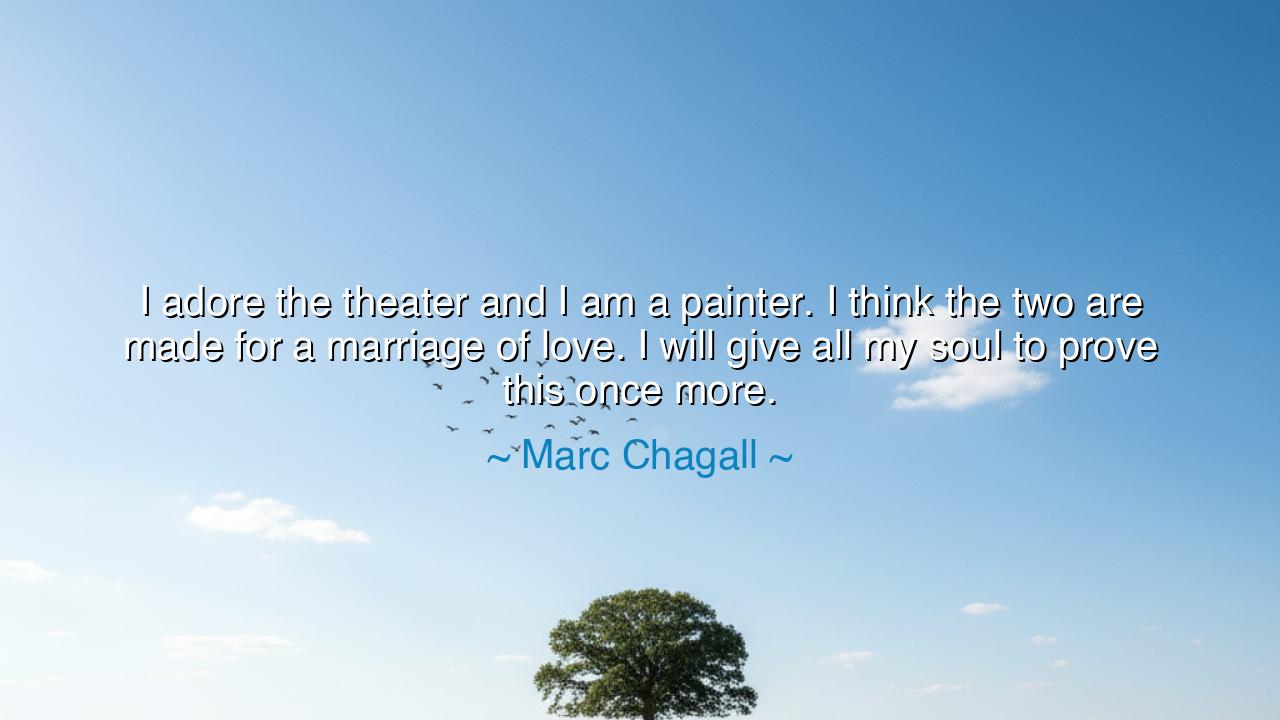
I adore the theater and I am a painter. I think the two are made
I adore the theater and I am a painter. I think the two are made for a marriage of love. I will give all my soul to prove this once more.






In the luminous words of Marc Chagall, the dreamer of color and light, we find not merely an artist’s declaration but a hymn to creation itself: “I adore the theater and I am a painter. I think the two are made for a marriage of love. I will give all my soul to prove this once more.” Here speaks a soul aflame with vision—a man who saw the arts not as separate kingdoms, but as lovers destined to unite. To Chagall, painting and theater were not crafts, but living beings, breathing and yearning for each other, each completing what the other lacked. His vow to “give all his soul” was not a metaphor; it was his sacred offering to beauty.
Born amid the mystic snows of Vitebsk, raised among the prayers of synagogues and the colors of peasant life, Chagall was a man who painted dreams as though they were memories. Yet he was no prisoner of canvas alone. When he turned his eye toward the theater, he found there another form of his art—the same longing for wonder, for transcendence, for light made visible through motion and music. To him, the stage was but a painting in motion, and the painting, a theater frozen in eternity. Thus he declared their union a marriage of love, for both seek to awaken the same divinity in the human heart—the power to feel, to imagine, to believe.
To understand his words, we must see as he saw: that art is not divided by medium, but united by spirit. The painter and the actor are siblings in creation, one wielding color, the other breath. In ancient Greece, where art was worship and theater divine, the same fire burned. When the sculptor Phidias carved the gods of Olympus, he sought the same immortality that Aeschylus and Sophocles sought in their tragedies. Both painted the human soul—one in marble, one in words. They knew, as Chagall did centuries later, that all art springs from the same sacred well: the desire to reveal the invisible through the visible.
Chagall’s own “marriage of love” between painting and theater came alive in his work for the stage—the ballet Aleko, the opera The Magic Flute, and his soaring designs for the Paris Opera House. He did not simply decorate the stage; he transformed it. His sets were dreams given wings, his costumes, brushstrokes in motion. He poured his soul into proving that color could sing, and music could glow—that sight and sound were not rivals, but lovers entwined. His vision was not to adorn performance, but to make art itself perform. And in that sacred endeavor, he blurred the lines between artist and poet, between painter and magician.
Yet there is a deeper truth within his vow—one that transcends art. When Chagall says, “I will give all my soul to prove this once more,” he speaks to the eternal necessity of passion. He reminds us that every great creation, whether on canvas or stage or in the quiet labor of life, demands the giving of the soul. The ancients would have called this devotio—the holy act of offering one’s spirit to the gods through one’s craft. To create without sacrifice is to paint without color, to sing without breath. It is only when the artist gives himself entirely that his work breathes with immortal life.
Consider Leonardo da Vinci, who saw no boundary between art and science, between painting and invention. To him, all knowledge was one great organism, every branch feeding the same trunk of wonder. Chagall’s vision stands in this same lineage of unity. He did not seek to separate, but to join—to remind us that all forms of creation are part of one vast symphony. The theater gives art its motion; painting gives it permanence. When they meet, as in Chagall’s work, they birth something eternal: the dance of the human spirit itself.
And so, the lesson for all who hear these words is clear: do not divide what was made to belong together. Whether in art, in love, or in life, seek the marriage of opposites—the blending of soul and skill, of dream and discipline. If you are an artist, give your whole being to your creation. If you are a dreamer, give your dream a stage upon which to live. For Chagall’s wisdom tells us that life itself is the greatest theater, and every soul its painter. To live truly, one must love deeply—and to create truly, one must dare the marriage of love between what one imagines and what one makes real.
Let your days, then, be your canvas, and your actions, your performance. Adore the world as Chagall adored the theater, and pour your spirit into its light as he poured his into color. For in doing so, you, too, will prove that all art—indeed, all life—is a sacred union between vision and devotion, between the seen and the unseen. And those who give their souls fully to such a union will find themselves immortal, not in fame, but in beauty.






AAdministratorAdministrator
Welcome, honored guests. Please leave a comment, we will respond soon